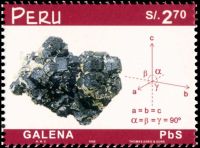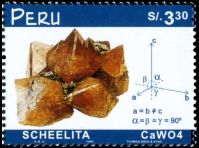Peru 1999 "Geology of Peru"
| <prev | back to index | next> |
| Issue Date | 03.07.1999 |
| ID | Michel: 1700-1702; Scott: 1230-1232; Stanley Gibbons: 2012-2014; Yvert et Tellier: 1192-1194; Category: pF |
| Design | Hugo Napan Vera |
| Stamps in set | 3 |
| Value |
S/. 2.70 - Galena.- PbS, cubic system S/. 3.30 - Scheelite.- CaWO4, tetragonal system S/. 5.00 - Virgotrigonia peterseni (mollusc) |
| Emission/Type | commemorative |
| Issue place | Lima |
| Size (width x height) | 30 mm x 40 mm |
| Layout | Sheets of 50 stamps |
| Products | FDC x1 |
| Paper | |
| Perforation | 13.5 x 14.00 |
| Print Technique | Offset, polychrome |
| Printed by | Thomas Greg & Sons of Colombia |
| Quantity | 1000.000 sets |
| Issuing Authority | Serpost |
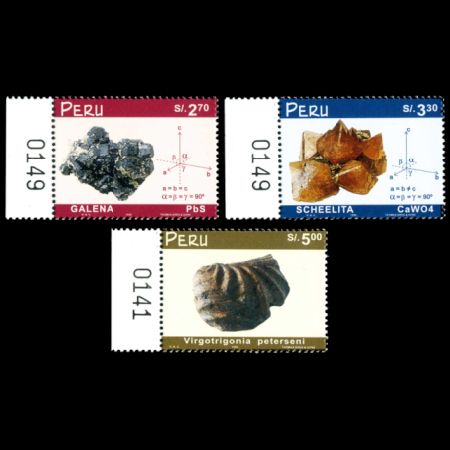
On July 3rd, 1999, the Post Authority of Peru: Serpost issued the set of three stamps shows two minerals and one fossil mollusc on it, to represent geological treasures of the country. A similar set, but unfortunately without any fossils, was issued three years later, on July 3rd, 2002 (Michel No. 1836-1838)
The following text is a quote from brochure issued by Serpost in 1999.
Virgotrigonia peterseni (Alleman, 1985).
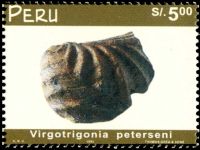
|
| Fossilized mollusc Virgotrigonia peterseni on stamp of Peru 1999 MiNr.: 1702, Scott: 1232. |
This specimen was collected and described by Vera Allerman in 1985 at Cerro La Virgen, Morro Solar, in the district of Chorrillos in Lima.
The name of the new species was given in honour of the prominent geologist Georg Petersen in recognition of his efforts which made possible the discovery and description of this new genus.
Other species of this genus are known in Chile and Argentina.
The fossiliferous formations at Morro Solar, Chorrillos, deserve to be protected.
Vera Alleman’s collection is deposited at the Museum of Natural History of the University Ricardo Palma.
Products and associated philatelic items
| FDC | ||
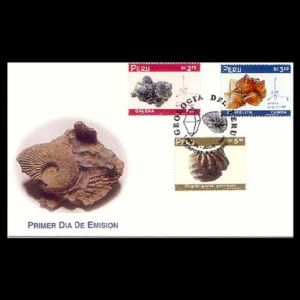 |
|
|

|

|
References
- Technical details and stamps presentation:
Official brochure, colnect
Acknowledgements
- Many thanks to fellow stamp collector Carlos moniker "PeruCollector" from Peru, for his help finding some information about these stamps
- Many thanks to Dr. Peter Voice from Department of Geological and Environmental Sciences, Western Michigan University, for reviewing the draft page and his very valuable comments.
| <prev | back to index | next> |
